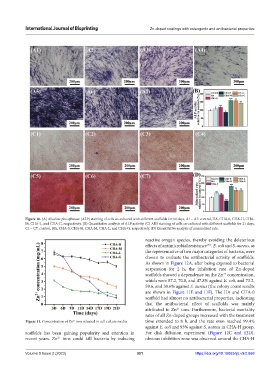Page 309 - IJB-9-2
P. 309
International Journal of Bioprinting Zn-doped coatings with osteogenic and antibacterial properties
Figure 10. (A) Alkaline phosphatase (ALP) staining of cells co-cultured with different scaffolds for 14 days, A1 – A7: control, HA, CHA-0, CHA-H, CHA-
M, CHA-L, and CHA-G, respectively. (B) Quantitative analysis of ALP activity. (C) ARS staining of cells co-cultured with different scaffolds for 21 days,
C1 – C7: control, HA, CHA-0, CHA-H, CHA-M, CHA-L, and CHA-G, respectively. (D) Quantitative analysis of mineralized rate.
reactive oxygen species, thereby avoiding the deleterious
effects of antimicrobial resistance . E. coli and S. aureus, as
[51]
the representative of two major categories of bacteria, were
chosen to evaluate the antibacterial activity of scaffolds.
As shown in Figure 12A, after being exposed to bacterial
suspension for 2 h, the inhibition rate of Zn-doped
scaffolds showed a dependence on the Zn concentration,
2+
which were 87.2, 70.8, and 47.8% against E. coli, and 73.2,
59.6, and 39.6% against S. aureus (the colony count results
are shown in Figure 11E and 11F). The HA and CHA-0
scaffold had almost no antibacterial properties, indicating
that the antibacterial effect of scaffolds was mainly
attributed to Zn ions. Furthermore, bacterial mortality
2+
rates of all Zn-doped groups increased with the treatment
Figure 11. Concentration of Zn ions released in cell culture media. time extended to 8 h, and the rate even reached 99.4%
2+
against E. coli and 93% against S. aureus in CHA-H group.
scaffolds has been gaining popularity and attention in For disk diffusion experiment (Figure 12C and 12D),
recent years. Zn ions could kill bacteria by inducing obvious inhibition zone was observed around the CHA-H
2+
Volume 9 Issue 2 (2023) 301 https://doi.org/10.18063/ijb.v9i2.668

